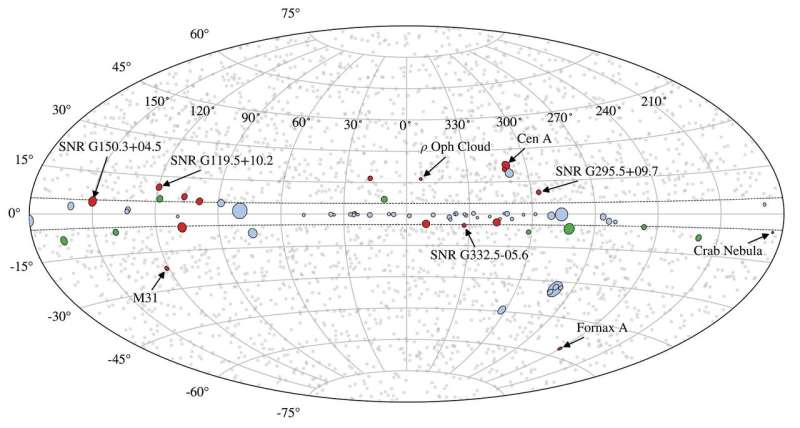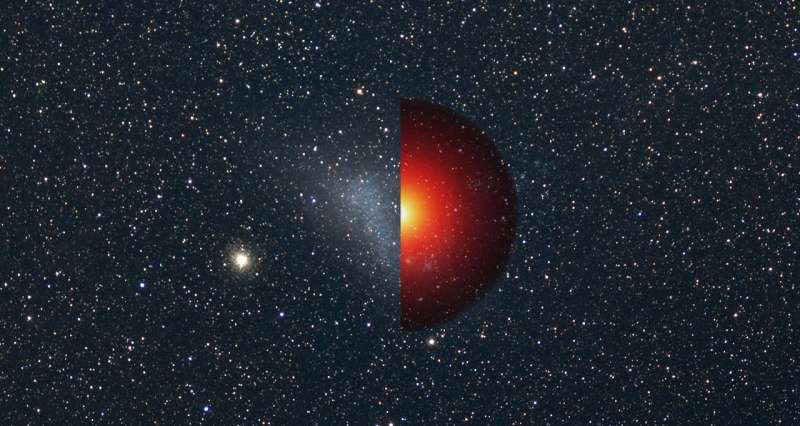Missing gamma-ray blobs shed new light on dark matter, cosmic magnetism

When astrophysicists look at the gamma-ray glow from a galaxy outside our own, all they typically see is a small spot because the galaxy is extremely far away. So, when a galaxy appears as an extended blob, something extraordinary must be going on that could help researchers better understand the properties of deep space.
Now, scientists, including researchers from the Department of Energy's SLAC National Accelerator Laboratory, have compiled the most detailed catalog of such blobs using eight years of data collected with the Large Area Telescope (LAT) on NASA's Fermi Gamma-Ray Space Telescope. The blobs, including 19 gamma-ray sources that weren't known to be extended before, provide crucial information on how stars are born, how they die, and how galaxies spew out matter trillions of miles into space.
Intriguingly, though, it was the cosmic regions where they didn't find blobs that shed new light on two particularly mysterious ingredients of the universe: dark matter – an invisible form of matter six times more prevalent than regular matter – and the magnetic field that pervades the space between galaxies and whose origin is unknown.
"These data are very exciting because they allow us to study some of the most fundamental processes in the universe, and they could potentially lead us to discover completely new physics," says NASA scientist Regina Caputo, one of the leaders of the recent study by the international Fermi-LAT collaboration, which was published in the Astrophysical Journal.
Clumps of dark matter

One of the things the researchers looked for were gamma-ray blobs associated with companion galaxies orbiting our Milky Way. Since the faintest of these satellites contain very few stars, they are thought to be held together by dark matter.
Scientists believe dark matter could be made of particles called WIMPs, which would emit gamma rays when they collide and destroy each other. A gamma-ray blob signal coming from an ultrafaint satellite galaxy would be a strong hint that WIMPS exist.
"Our simulations of galaxy formation predict that there should be more satellite galaxies than those we've been able to detect in optical surveys," Caputo says. "Some of them could be so faint that we might only be able to see them if they produced gamma rays due to dark matter annihilation."
In the new study, the Fermi-LAT researchers searched for gamma-ray blobs associated with those predicted satellite galaxies. They didn't find any. But even the fact that they came up empty-handed is an important result: It will allow them, in future studies, to define the distribution of dark matter in Milky Way satellites and the likelihood that WIMPs produce gamma rays. It also provides new input for models of galaxy evolution.
Faint cosmic magnetism
The researchers also used their data to obtain more information on the strength of the magnetic field between galaxies, which they hope will be an important puzzle piece in determining the origin of the field.
For this part of the study, the team looked at blazars – active galaxies that spit high-speed jets of plasma far into space. The Fermi spacecraft can detect gamma rays associated with jets that point in the direction of the Earth.
Blazars appear as point-like sources, but a mechanism involving the intergalactic magnetic field could potentially make them look like extended sources, says Manuel Meyer, a Humboldt fellow at the Kavli Institute for Particle Astrophysics and Cosmology (KIPAC) and another lead author of the study.
The researchers didn't find any blobs associated with blazars. Again, this no-show was valuable information: It allowed the team to calculate that the magnetic field is at least a tenth of a millionth billionth as strong as Earth's magnetic field. The magnetic field's upper limit – a billion times weaker than Earth's field – was already known.
The intergalactic field is stronger than the researchers had expected, Meyer says, and this new information might help them find out whether it stems from material spilled into space in recent times or whether it was created in processes that occurred in earlier cosmic history.
The cosmic magnetism could also have ties to dark matter. In an alternative to the WIMP model, dark matter is proposed to be made of lighter particles called axions that could emerge from gamma rays (and convert back into them) in the presence of a magnetic field. "For that to occur, the field strength would need to be closer to its upper limit, though," Meyer says. "It's definitely interesting to take this mechanism into account in our dark matter studies, and we're doing this right now within the Fermi-LAT collaboration."
More information: M. Ackermann et al. The Search for Spatial Extension in High-latitude Sources Detected by the Fermi Large Area Telescope, The Astrophysical Journal Supplement Series (2018). DOI: 10.3847/1538-4365/aacdf7
Journal information: Astrophysical Journal
Provided by SLAC National Accelerator Laboratory





















